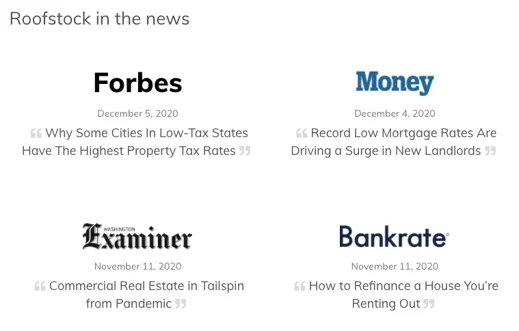
3 Examples of Great Real Estate Investment Content Marketing
3 Examples of Great Real Estate Investment Content Marketing
Alyssa Patzius, VP of Sales • Intero Digital • December 22, 2020

Nearly 80% of B2B marketers have a content marketing strategy. Why? Because content marketing is a great way to grow an organization and create value for its target audience. Yes, this is even true for real estate investment companies.
There are four primary ways content marketing can help you reach your business goals:
• Thought leadership: Creating and distributing helpful, relevant content can position your real estate investment company as an expert in front of your target audience and can build trust.
• Lead generation: Content is an effective way to get your foot in the door with potential clients and turn them into leads by gathering their contact information in exchange for gated resources.
• Sales enablement: Once your audience members become leads, you can use targeted content to nurture individual leads closer to closing.
• SEO: When your ideal audience searches for information about your area of expertise, you can show up in search results as a solution to their questions and pain points if you create content that speaks to keywords related to those queries.
3 Examples of Real Estate Investment Content Marketing
Knowing that content is valuable is very different from actually being able to visualize how it can help your organization work toward your goals. To help you make that leap, I’ve rounded up three examples of great content marketing in the real estate investment industry:
Origin Investments
Origin Insights is a blog that’s all about “educating individuals about real estate investing.” This blog by Origin Investments covers various relevant topics, including real estate investing 101, more advanced subject matter, industry news, and webinar recordings. By providing so much educational content relevant to its audience, Origin Investments is positioning itself as a one-stop shop for real estate investment knowledge.
One example of Origin’s blog content covers the topic of multifamily investment performance. The article outlines indicators and trends that suggest strong multifamily investment performance in the near future. This type of content can help Origin’s audience determine what their future investment plans might look like — and it positions Origin as a helpful expert.

CrowdStreet
Content marketing involves far more than blog content. CrowdStreet is taking advantage of the power of content in the help center on its website. The help center bursts with informative content covering topics including CrowdStreet 101, the fundamentals of commercial real estate, and the CrowdStreet investment process.
For example, let’s take a look at the portion of the help center that focuses on the fundamentals of commercial real estate. This section lists numerous questions CrowdStreet’s audience might have. Visitors can peruse the list of questions, click through to read the answers, and then access any related content.

This well-organized help center allows CrowdStreet to position its website as a destination for those who want to learn more about real estate investment. Providing this helpful content that answers the audience’s questions also helps CrowdStreet rank in search results for those questions and keywords.
Roofstock
Origin Investments’ blog and CrowdStreet’s help center are great examples of on-site owned media, but earned media is also a component of a strong content marketing strategy — and Roofstock is definitely taking advantage of this.
On its website, Roofstock has a page dedicated to compiling all its press mentions (mentions of the company in third-party publications). The articles that mention Roofstock cover subjects that would interest the company’s audience: property tax rates, the effects of COVID-19 on commercial real estate, industry tech changes, and mortgage rates.

Being featured in external publications allows Roofstock to widen its reach to include the audiences of these publications. It also allows the company to garner third-party credibility, which can bolster Roofstock’s reputation as a trusted entity in the real estate investment space.
These are just a few examples of how real estate investment companies can use content marketing to build their thought leadership and connect with their target audiences. If you’d like to explore what content marketing might look like for your unique organization, click below to set up a call with one of our content marketing experts!
